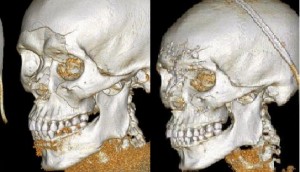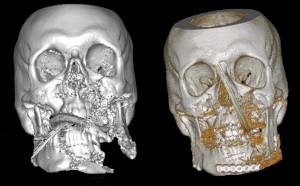 Maxillofacial injury also known as Facial trauma is an unfortunate result of many accidents. Facial Injuries can result from sport mishaps, on-the-job accidents, motor vehicle accidents, accidents at home, interpersonal violence to name a few.
Maxillofacial injury also known as Facial trauma is an unfortunate result of many accidents. Facial Injuries can result from sport mishaps, on-the-job accidents, motor vehicle accidents, accidents at home, interpersonal violence to name a few.
The facial bone architecture that encompass the face is an amazing structure designed to protect its contents. Just as a car has compression zones to protect its passengers upon impact, the facial bones have many vertical and horizontal buttresses designed to crumple under extreme stress/trauma in order to protect its vital structures, the eyes and brain.
If you notice a person with facial trauma unconscious, dizzy, nauseous or otherwise unable to respond or move. Please do not move them, Call 911 immediately. If those signs are not present, but feel the trauma was severe enough to warrant evaluation, you should call your Oral and Maxillofacial Surgeon or present to the nearest emergency room for evaluation.
 While at the hospital, the patient will be seen by many medical professionals, more than likely including an Oral and Maxillofacial Surgeon. Due to their unique training encompassing both the dental and medical fields, Oral and Maxillofacial Surgeons are some of the highest qualified personnel to treat facial trauma. In some cases of facial trauma, bone and/or skin deficits may result. Oral and Maxillofacial Surgeons are well equipped to address many of these deficits with various means of hard and soft tissue grafting. Their understanding of both form and function of the maxillofacial skeleton and soft tissue is what sets Oral and Maxillofacial Surgeons apart from any other surgical specialty.
While at the hospital, the patient will be seen by many medical professionals, more than likely including an Oral and Maxillofacial Surgeon. Due to their unique training encompassing both the dental and medical fields, Oral and Maxillofacial Surgeons are some of the highest qualified personnel to treat facial trauma. In some cases of facial trauma, bone and/or skin deficits may result. Oral and Maxillofacial Surgeons are well equipped to address many of these deficits with various means of hard and soft tissue grafting. Their understanding of both form and function of the maxillofacial skeleton and soft tissue is what sets Oral and Maxillofacial Surgeons apart from any other surgical specialty.
Please visit American Association of Oral and Maxillofacial Surgeons for more information.